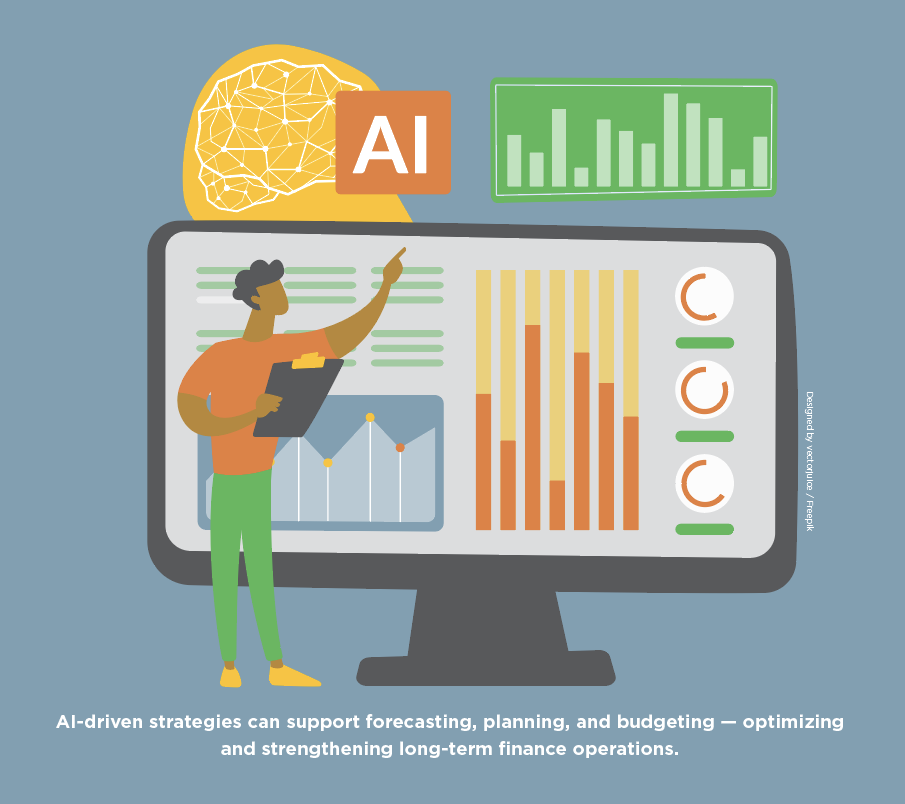As supply chain disruptions and uncertainty continue, organizations have embraced artificial intelligence (AI) to safeguard their operations and stay ahead of the competition. Discover which AI technologies teams have integrated into their procedures and how these groundbreaking solutions have impacted forecasting, planning, and budgeting.
The accelerated adoption of AI technology
After the COVID-19 pandemic revealed how susceptible the global supply chain is to disruptions, organizations quickly recognized the need to improve agility and resilience. Teams are increasingly turning to AI tools to deliver the powerful optimization capabilities required for more accurate planning and financing — all while reducing costs and promoting sustainability. What has contributed to the widespread adoption of AI across the entire value chain? Here are some of the key drivers:
- The increasing complexity of supply chain networks, global markets, and consumer demands has necessitated solutions that can handle massive amounts of data and streamline operations.
- Organizations need greater operational efficiency and flexibility to respond quickly to market changes and demand fluctuations.
- With large datasets available, teams need AI-powered analytics and machine learning models to extract actionable insights and enable informed decision-making.
- Businesses want to identify and mitigate potential disruptions and boost resilience to ensure operational continuity in the face of future uncertainties.
Utilizing AI tools for forecasting, planning, and finance functions
Enhancing organizational planning and management is crucial to optimizing operations and controlling costs — which is more important than ever while supply chain uncertainty continues. Consider the following AI-driven solutions that businesses are introducing to reach their goals:
- Machine learning models and predictive analytics
AI-powered demand forecasting tools use advanced algorithms to analyze historical data, market trends, and other external factors. These tools enable companies to make more accurate predictions about future demand levels. Actionable insights into what is needed to maintain inventory levels and reduce stockouts support the organizational planning process.
- Supply chain optimization
AI-optimization tools empower supply chain managers to maximize the potential of every facet of the business — from inventory levels and transportation costs to production schedules and demand fluctuations. As a result, these algorithms help align resource utilization with forecasting and budgeting processes.
- Robotic process automation (RPA)
By deploying RPA, organizations can automate repetitive tasks within supply chain processes. These processes include everyday undertakings such as order processing, inventory management, and invoice reconciliation. According to Adobe, executives are also looking for AI to alleviate menial tasks like paperwork (82%), scheduling (79%), and timesheets (78%). Interweaving this technology into existing systems frees up human resource teams, reduces errors, and improves efficiency — inevitably enhancing planning and financing.
- Blockchain technology
With Gartner reporting that 60% of CIOs plan to adopt some level of blockchain technologies in the coming years, it is clear why this has become a big topic of discussion in the supply chain landscape. Visibility has become increasingly essential, and blockchain technology enables transparent, secure, and traceable transactions across production and distribution networks. By using smart contracts and distributed ledgers to boost oversight, organizations can streamline financial planning and budgeting processes, like invoice verification, payment settlements, and trade finance.

The potential challenges and benefits of AI-driven solutions
Although the AI tools discussed above demonstrate the immense potential this technology holds for supply chain forecasting, planning, and financing, there are challenges that organizations must navigate in the process:
- Data quality and availability pose an issue as teams face limited access to high-quality information.
- Integrating AI tools with existing systems and infrastructure can cause hurdles if systems are non-compatible.
- Research consistently shows that AI systems can exhibit human and systemic biases stemming from their program and data sources. Businesses need proactive measures to ensure equitable AI adoption.
- High implementation costs are a common financial barrier for supply chain organizations, requiring upfront investments in more advanced technology infrastructure.
On the other hand, when supply chain organizations overcome barriers to AI adoption and integrate this technology successfully, they can see several resulting benefits. With AI-augmented processes for forecasting, planning, and budgeting, teams can:
- Leverage real-time decision-making: AI-driven analytics provide real-time insights and actionable data that enable supply chain executives to make informed decisions faster.
- Enhance forecast accuracy: By quickly analyzing vast amounts of data, organizations can ensure more accurate forecasting and planning.
- Boost risk mitigation and resilience: AI technology can identify potential risks, like supplier disruptions or transportation delays, before disaster strikes — minimizing impact and ensuring business continuity.
- Harmonize inventory levels: With more information about demand patterns, seasonality, lead times, and market trends, businesses enjoy more efficient inventory management.
- Optimize resource allocation: Resources are precious, and AI algorithms help ensure asset allocation, such as labor or equipment, is aligned with demand patterns and operational capacity.
Unleashing the power of AI tools with Oracle Cloud solutions
With the ability to provide more accurate predictions, uncover hidden insights, and ensure real-time adjustments, AI technologies promise to disrupt budgeting and forecasting in the coming years. Oracle Cloud EPM can help organizations navigate planning and financing with Intelligent Performance Management (IPM) capabilities.
That daunting process that once took weeks to complete? Now users can finish in days, or maybe even hours, with the help of Oracle Cloud EPM. Take advantage of predictive insights and automated data analysis — not to mention features like forecast variance and bias, prediction, and anomaly insight.
Inspirage helps customers select Oracle solutions to support their digital transformation journeys. With deep domain experience and a global workforce, Inspirage helps organizations implement Oracle Cloud enterprise performance management (EPM) and enterprise resource planning (ERP) solutions to optimize long-term operations. Ready to strengthen your forecasting and financing? Contact us to learn more.